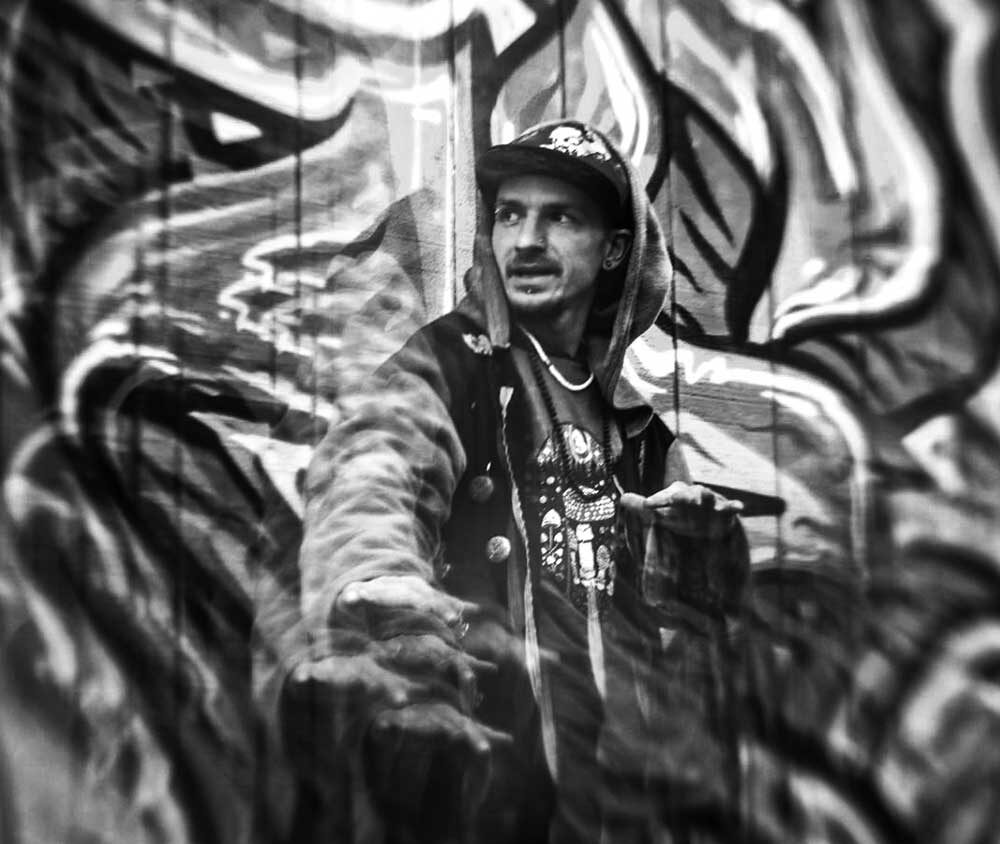Eugene filmmaker Peter De Reimer and spoken word poet Plaedo (Jasun Wellman) are members of a friends group who meet for dinner once a month to talk and “to do a share.” But in January only Plaedo and one other friend showed up to meet. It was boring, so they went outside and took a walk. They may have had mushrooms for dinner and on their walk, they talked and experienced some “profound thinking.”
Afterward, Plaedo continued these “walkabouts” with other friends, and when De Reimer heard, he asked if he could come along and film one. He followed the poet and “philosopher of play” for three hours, and the result is The Storyteller: A Eugene Walkabout, De Reimer’s first full-length film, made on the streets of Eugene.
He likens the one and a half-hour movie, which is premiering Oct. 23 at the Art House, to The Cruise (1998), a drive-along of New York City with tour bus guide Timothy Levitch. The Cruise won a 2000 Emmy in Special Classification for Outstanding News and Documentary Achievement. What was special about it wasn’t the amount of accurate information delivered about NYC, but rather the personality of the guide.
Such is the case, as well, with De Riemer’s documentary. We tour Eugene through Plaedo’s unique sensibility, life experiences and perspective. He grew up with hippie parents who sold marijuana during the outlaw days, went to Thailand and meditated with monks, then came back and earned a general studies and philosophy degree from the University of Idaho. He says his degree has sat in a box unused, but he thinks of himself as a “working philosopher.”
He is also a rapper who’s put out three solo albums, a poet and a community organizer. Shortly after coming to Eugene in 2011, he emceed an Occupy Eugene rally before about 1,800 people. Now he mentors youth and works with the unhoused and with Avant Gardeners, which bills itself as a “platform for developing a food gift economy.” In summers he travels the Northwest performing at festivals, colleges and other places where people gather.
The film begins downtown and then moves through the Whiteaker neighborhood, with Plaedo sharing his memories and philosophies as he goes. He talks about his time working on the street and shares thoughts he has about the city, especially its planning. Along the way, he interacts with people and with landmarks, such as sculptor Peter Helzer’s statue “The Storyteller” at Kesey Square, a memorial to novelist and counterculture icon Ken Kesey.
De Riemer gave Plaedo free rein to go where he pleased. No plan or dialogue was scripted — the entire movie was improvised. Speaking off the cuff, though, not everything Plaedo said about Eugene is entirely historically accurate. That’s where Eugene history tour guide Randy Gudeika comes into the picture; De Riemer inserts him after the fact.
Gudeika has given 33 tours of different neighborhoods in Eugene over the past six years. He met the filmmaker about a month after The Storyteller was shot, on the street, of all places, during the middle of one of his walking history tours.
De Riemer shaved down the footage from three hours to one, and is now in the process of editing, which not only includes inserting Gudeika’s remarks, but also related news and historical documents. These pieces of associated materials are included in the margins of the screen, so the format recalls that of a webpage where information sits on the periphery fighting for your attention. It also recollects, De Riemer says, the way you are drawn off your path as you walk in real life towards something different that’s caught your eye.
When I meet Gudeika, Plaedo and De Riemer, it’s at Mi Cafe on 11th Avenue. Plaedo has to leave the cafe early, and then it’s closing time, so De Riemer, Gudeika and I have to leave, too. We don’t find another place to sit, though. Instead, we stay on the street where I conduct my first ever walking interview.
Stopping to take notes, I pause at the corner of 10th Avenue and Washington Street, where Gudeika points out that Robert Clark (1910– 2005), president of the University of Oregon during the 1970 student occupation of Johnson Hall, lived his last years in the building on the corner. Though we’re not on a tour, he can’t help but share what he knows.
De Riemer moved to Eugene four years ago after a stint in Los Angeles, where he worked as a writer and editor, and honed his craft with other aspiring filmmakers. His day job in Eugene is as an editor at Northwest Media, a company that publishes courses for potential foster parents. He hadn’t thought about making movies since being here — until he heard about Plaedo’s walks.
Another local filmmaker whose work will soon be screened at the Art House is Marlin Darrah, the director of An Egypt Affair. Winner of 19 festival awards, the thriller will be shown at 7 pm Monday, Oct. 30.
You don’t have to be religious to appreciate the architecture of the Art House theater, which was built in the 1920s and originally designed as a church. Some argue that theaters function as our current houses of worship, providing the stories or myths we gather around and celebrate. In which case, showing The Storyteller in an old church is entirely appropriate since Plaedo compares his walks through Eugene to the ritual journey of the Australian Aboriginal walkabout.
He will be at the Art House ahead of the film, so come early to meet him or to hear a bit more about the history of the building from Gudeika.
